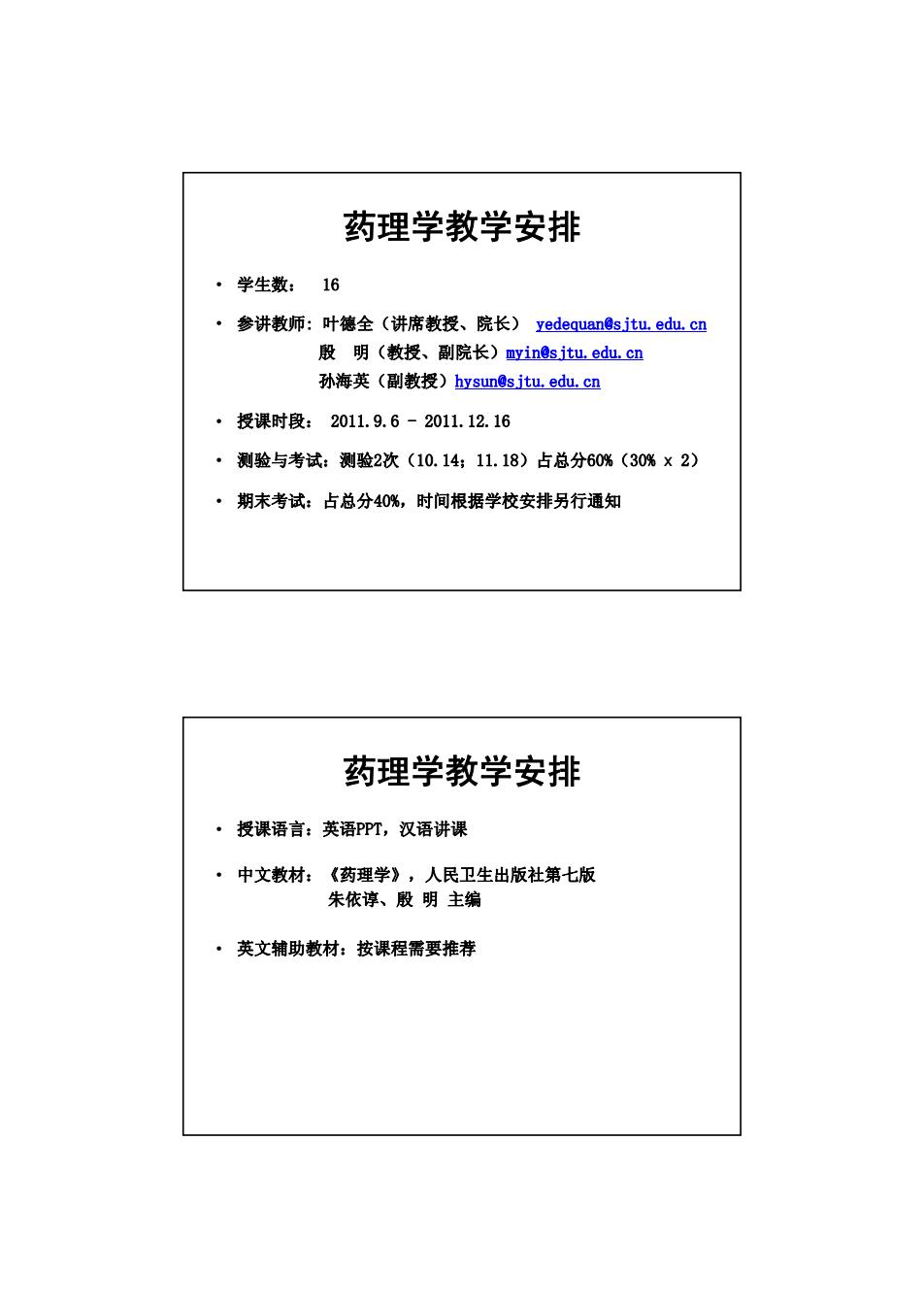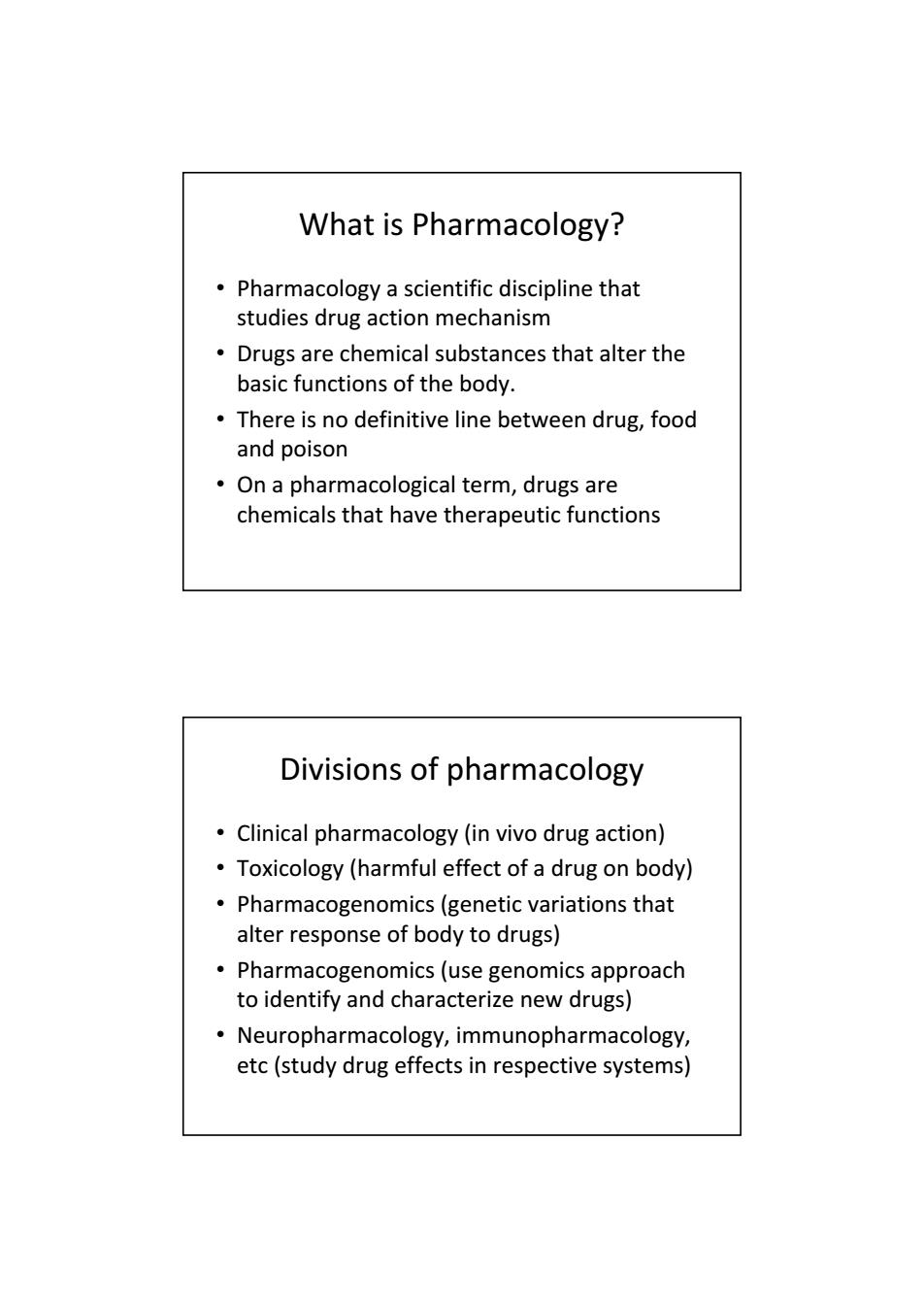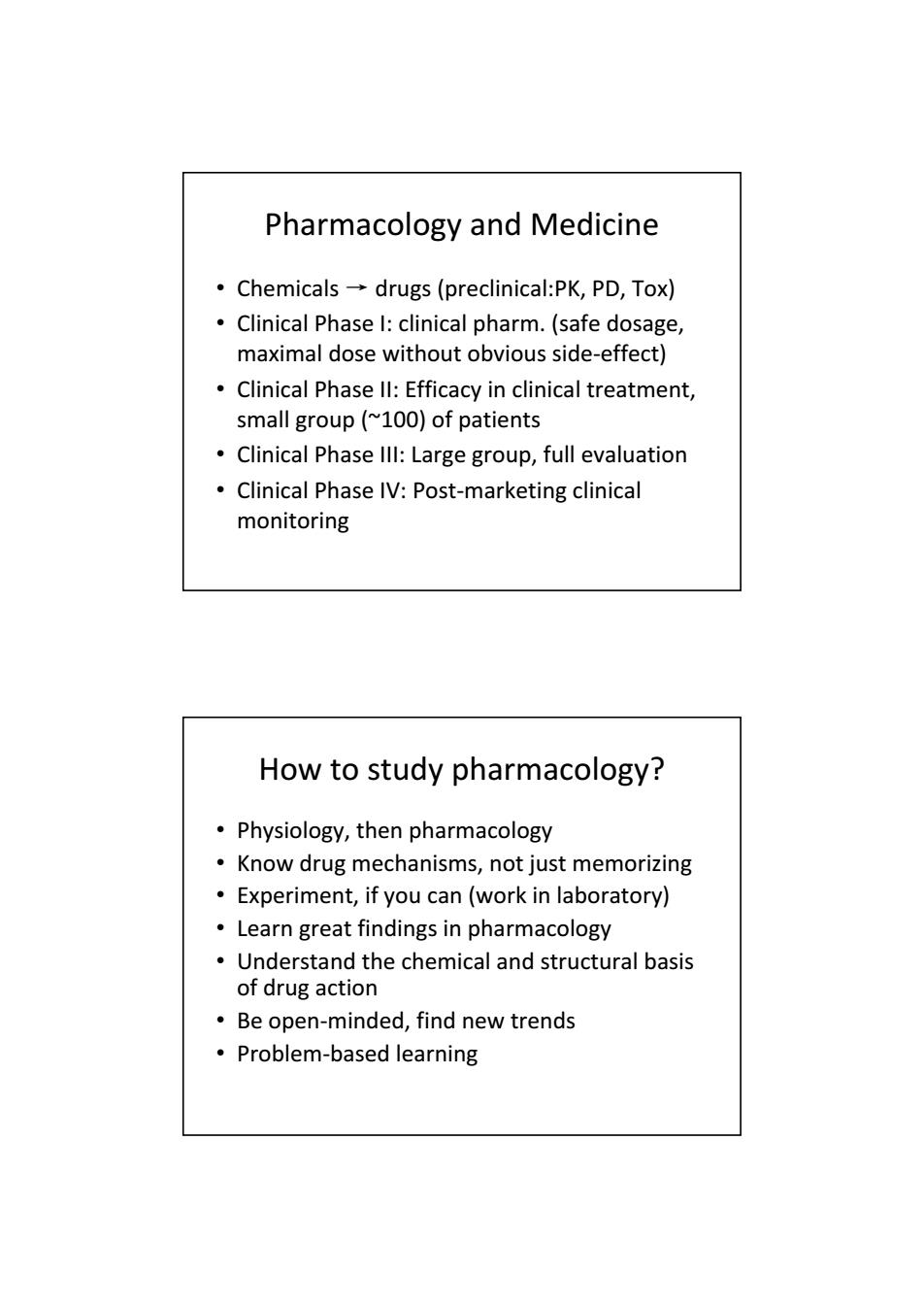
药理学教学安排 学生数:16 ·参讲教师:叶德全(讲席教授、院长)yedequan@(sjtu,edu,cn 殷明(教授、副院长)myin@s jtu.edu.cn 孙海英(副教授)hysun@sjtu,edu,cn ·授课时段:2011.9.6-2011.12.16 测验与考试:测验2次(10.14;11.18)占总分60%(30%×2) ·期末考试:占总分40%,时间根据学校安排另行通知 药理学教学安排 授课语言:英语PPT,汉语讲课 中文教材:《药理学》,人民卫生出版社第七版 朱依谆、殷明主编 英文辅助教材:按课程需要推荐
药理学教学安排 • 学生数: 16 • 参讲教师: 叶德全(讲席教授、院长) yedequan@sjtu.edu.cn 殷 明(教授、副院长)myin@sjtu.edu.cn 孙海英(副教授)hysun@sjtu.edu.cn • 授课时段: 2011.9.6 - 2011.12.16 • 测验与考试:测验2次(10.14;11.18)占总分60%(30% x 2) • 期末考试:占总分40%,时间根据学校安排另行通知 药理学教学安排 • 授课语言:英语PPT,汉语讲课 • 中文教材:《药理学》,人民卫生出版社第七版 朱依谆、殷 明 主编 • 英文辅助教材:按课程需要推荐

What is Pharmacology? Pharmacology a scientific discipline that studies drug action mechanism Drugs are chemical substances that alter the basic functions of the body. There is no definitive line between drug,food and poison On a pharmacological term,drugs are chemicals that have therapeutic functions Divisions of pharmacology Clinical pharmacology (in vivo drug action) Toxicology(harmful effect of a drug on body) Pharmacogenomics(genetic variations that alter response of body to drugs) Pharmacogenomics(use genomics approach to identify and characterize new drugs) Neuropharmacology,immunopharmacology, etc(study drug effects in respective systems)
What is Pharmacology? • Pharmacology a scientific discipline that studies drug action mechanism • Drugs are chemical substances that alter the basic functions of the body. • There is no definitive line between drug, food and poison • On a pharmacological term, drugs are chemicals that have therapeutic functions Divisions of pharmacology • Clinical pharmacology (in vivo drug action) • Toxicology (harmful effect of a drug on body) • Pharmacogenomics (genetic variations that alter response of body to drugs) • Pharmacogenomics (use genomics approach to identify and characterize new drugs) • Neuropharmacology, immunopharmacology, etc (study drug effects in respective systems)

Pharmacology and Medicine ·Chemicals→drugs(preclinical::PK,PD,Tox) Clinical Phase I:clinical pharm.(safe dosage, maximal dose without obvious side-effect) Clinical Phase ll:Efficacy in clinical treatment, small group(~100)of patients Clinical Phase Ill:Large group,full evaluation Clinical Phase IV:Post-marketing clinical monitoring How to study pharmacology? Physiology,then pharmacology Know drug mechanisms,not just memorizing Experiment,if you can(work in laboratory) Learn great findings in pharmacology Understand the chemical and structural basis of drug action Be open-minded,find new trends Problem-based learning
Pharmacology and Medicine • Chemicals → drugs (preclinical:PK, PD, Tox) • Clinical Phase I: clinical pharm. (safe dosage, maximal dose without obvious side‐effect) • Clinical Phase II: Efficacy in clinical treatment, small group (~100) of patients • Clinical Phase III: Large group, full evaluation • Clinical Phase IV: Post‐marketing clinical monitoring How to study pharmacology? • Physiology, then pharmacology • Know drug mechanisms, not just memorizing • Experiment, if you can (work in laboratory) • Learn great findings in pharmacology • Understand the chemical and structural basis of drug action • Be open‐minded, find new trends • Problem‐based learning

Pharmacokinetics Drug disposition ADME ·Absorption ·Distribution Metabolism(biotransformation) ·Excretion Quantification of drug concentration in the body,and mathematic modeling ADME of a drug taken orally Oral administration Blood Bound drug Gut_ Absorption Free drug Metabolite Excretion Urine Target organ Liver
Pharmacokinetics • Drug disposition = ADME • Absorption • Distribution • Metabolism (biotransformation) • Excretion • Quantification of drug concentration in the body, and mathematic modeling ADME of a drug taken orally

Absorption:route of administration Two major routes of drug administration: Enteral vs.Parenteral Enteral:oral,sublingual,rectal Parenteral:intravenous,intramuscular, subcutaneous,intraperitoneal,topical, intrathecal,pulmonary Each of these two major routes have advantages and disadvantages Route of drug administration Drugs'Administration routes Buc Per-Mucco Rectal venous route
Absorption: route of administration • Two major routes of drug administration: Enteral vs. Parenteral • Enteral: oral, sublingual, rectal • Parenteral: intravenous, intramuscular, subcutaneous, intraperitoneal, topical, intrathecal, pulmonary • Each of these two major routes have advantages and disadvantages Route of drug administration